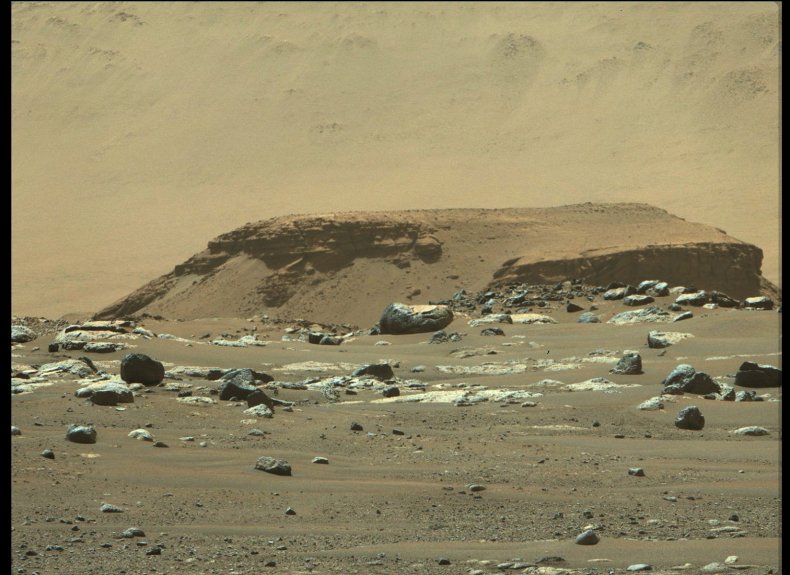
NASA's Perseverance rover has captured a spectacular image of an area near its landing site that scientists believe was the location where an ancient Martian lake and river once joined.
The rover's landing site, which NASA has named after the late science fiction author Octavia E. Butler, lies in the 28-mile-wide Jezero Crater, which researchers think was home to a river delta billions of years ago—making it a promising spot to search for signs of ancient microbial life.
On February 22, Perseverance snapped an image from its landing site that shows the remnant of a fan-shaped deposit of sediments known as a delta using its Mastcam-Z camera system.According to NASA, scientists think this delta is what remains of the confluence between an ancient river and lake that once lay in the crater.
In the image, the delta remnant is the raised area of a dark brown rock in the middle of the shot. The remnant is located around 1.4 miles to the west of the Octavia E. Butler landing site.The visible part of the remnant is around 660 feet across, NASA said. The colors in the picture are an approximation of what we would see with human eyes if we were looking at the geological feature on Mars.
The photo is the first high-resolution panorama from the Mastcam-Z system, the "main eyes" of the rover, according to the instrument's principal investigator Jim Bell.
Discussing the image in a virtual teleconference on Friday, Katie Stack Morgan, Perseverance deputy project scientist at NASA's Jet Propulsion Laboratory, said: "The rocks in the foreground may be similar to those in and around the rover's landing site. But I'd like to call attention to the rocks in the mound in the background.
"These rocks look notably different in that you can actually resolve layering within the rock you see in this outcrop. These resistant layered rocks were likely deposited by rivers flowing into the ancient Lake Jezero and scientists on the team are hard at work trying to understand the significance and origin of rocks like this, that we're seeing on the ground at the landing site for the very first time."
But before the rover can begin exploring the delta, the Perseverance team needs to work out how to get there. Morgan said the science team is currently working with engineers to determine the best path—i.e. the safest, most efficient and most scientifically interesting route—for the rover to drive to the delta.
Once the rover arrives at the mouth of the river that once entered Jezero, Morgan said it will likely deposit its very first sample depot.The rover is capable of collecting samples and depositing them in special tubes, while recording their location on the surface. Future missions to Mars will hopefully be able to pick up these samples and return them to Earth for detailed analysis.
On March 4, the rover completed its first drive on Mars, travelling 21.3 feet across the surface in a mobility test that served as an important milestone for the early part of the mission.
Over the first two weeks or so of its mission, the rover has already sent around 7,000 images back to Earth, "including our first views of some of the geologic targets of exploration that brought the rover to Jezero," Morgan sai



No comments:
Post a Comment